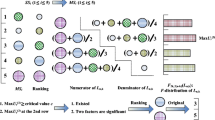Abstract
In order to optimize the crashworthy characteristic of energy-absorbing structures, the surrogate models of specific energy absorption (SEA) and ratio of SEA to initial peak force (REAF) with respect to the design parameters were respectively constructed based on surrogate model optimization methods (polynomial response surface method (PRSM) and Kriging method (KM)). Firstly, the sample data were prepared through the design of experiment (DOE). Then, the test data models were set up based on the theory of surrogate model, and the data samples were trained to obtain the response relationship between the SEA & REAF and design parameters. At last, the structure optimal parameters were obtained by visual analysis and genetic algorithm (GA). The results indicate that the KM, where the local interpolation method is used in Gauss correlation function, has the highest fitting accuracy and the structure optimal parameters are obtained as: the SEA of 29.8558 kJ/kg (corresponding to a=70 mm and t= 3.5 mm) and REAF of 0.2896 (corresponding to a=70 mm and t=1.9615 mm). The basis function of the quartic PRSM with higher order than that of the quadratic PRSM, and the mutual influence of the design variables are considered, so the fitting accuracy of the quartic PRSM is higher than that of the quadratic PRSM.
Similar content being viewed by others
References
TANG Z, LIU S, ZHANG Z. Energy absorption properties of non-convex multi-corner thin-walled columns [J]. Thin-Walled Structures, 2012, 51(2): 112–120.
TIAN H Q, GAO G J, YAO S, LIU H. Structure realization method for collapse threshold of plastic deformation in train collision condition [J]. Journal of Central South University of Technology, 2011, 18(1): 244–249.
ABRAMOWICZ W. Thin-walled structures as impact energy absorbers [J]. Thin-Walled Structures, 2003, 41(2/3): 91–107.
NAGEL G M, THAMBIRATNAM D P. Computer simulation and energy absorption of tapered thin-walled rectangular tubes [J]. Thin-Walled Structures, 2005, 43(8): 1225–1242.
AVALLE M, CHIANDUSSI G. Optimisation of a vehicle energy absorbing steel component with experimental validation [J]. International Journal of Impact Engineering, 2007, 34(4): 843–858.
NAGEL G M, THAMBIRATNAM D P. Dynamic simulation and energy absorption of tapered thin-walled tubes under oblique impact loading [J]. International Journal of Impact Engineering, 2006, 32(10): 1595–1620.
REDHE M, NILSSON L. A method to determine structural sensitivities in vehicle crashworthiness design [J]. International Journal of Crashworthiness, 2002, 7(2): 179–190.
CENGIZ B, EMIN S, SUREYYA E B, FATIH A, TOPPAK T, MUGAN A. Railroad passenger car collision analysis and modifications for improved crashworthiness [J]. International Journal of Crashworthiness, 2011, 16(3): 319–329.
LIAO X, LI Q, YANG X, LI W, ZHANG W G. A two-stage multi-objective optimisation of vehicle crashworthiness under frontal impact [J]. International Journal of Crashworthiness, 2008, 13(3): 279–288.
REDHE M, GIGER M, NILSSON L. An investigation of structural optimization in crashworthiness design using a stochastic approach [J]. Structural and Multidisciplinary Optimization, 2004, 27(6): 446–459.
FORSBERG J, NILSSON L. On polynomial response surfaces and Kriging for use in structural optimization of crashworthiness [J]. Structural and Multidisciplinary Optimization, 2005, 29(3): 232–243.
YU K, YANG X, YUE Z. Aerodynamic and heat transfer design optimization of internally cooling turbine blade based different surrogate models [J]. Structural and Multidisciplinary Optimization, 2011, 44(1): 75–83.
EOM Y, YOO K, PARK J, HAN S. Reliability-based topology optimization using a standard response surface method for three-dimensional structures [J]. Structural and Multidisciplinary Optimization, 2011, 43(2): 287–295.
HOU S, HAN X, SUN G Y, LONG S Y, LI W, YANG X J, LI Q. Multiobjective optimization for tapered circular tubes [J]. Thin-Walled Structures, 2011, 49(7): 855–863.
HUANG Z J, WANG C G, CHEN J, TIAN H. Optimal design of aeroengine turbine disc based on Kriging surrogate models [J]. Computers and Structures, 2011, 89(1/2): 27–37.
LIU H, MAGHSOODLOO S. Simulation optimization based on Taylor Kriging and evolutionary algorithm [J]. Applied Soft Computing, 2011, 11(4): 3451–3462.
QASEM S N, SHAMSUDDIN S M, ZAIN A M. Multi-objective hybrid evolutionary algorithms for radial basis function neural network design [J]. Knowledge-Based Systems, 2012, 27(1): 475–497.
SEKULSKI Z. Multi-objective topology and size optimization of high-speed vehicle-passenger catamaran structure by genetic algorithm [J]. Marine Structures, 2010, 23(4): 405–433.
AZADI S, AZADI M, ZAHEDI F. NVH analysis and improvement of a vehicle body structure using DOE method [J]. Journal of Mechanical Science and Technology, 2009, 23(11): 2980–2989.
LI G, WANG H, ARYASOMAYAJULA S R, GRANDHI R V. Two-level optimization of airframe structures using response surface approximation [J]. Structural and Multidisciplinary Optimization, 2000, 20(2): 116–124.
WANG H, ZHU X, DU Z. Aerodynamic optimization for low pressure turbine exhaust hood using Kriging surrogate model [J]. International Communications in Heat and Mass Transfer, 2010, 37(8): 998–1003.
GOMES H M, AWRUCH A M, LOPES P A M. Reliability based optimization of laminated composite structures using genetic algorithms and Artificial Neural Networks [J]. Structural Safety, 2011, 33(3): 186–195.
Author information
Authors and Affiliations
Corresponding author
Additional information
Foundation item: Project(U1334208) supported by the National Natural Science Foundation of China; Project(2013GK2001) supported by the Fund of Hunan Provincial Science and Technology Department, China
Rights and permissions
About this article
Cite this article
Xie, Sc., Zhou, H. Multi-objective optimisation of a vehicle energy absorption structure based on surrogate model. J. Cent. South Univ. 21, 2539–2546 (2014). https://doi.org/10.1007/s11771-014-2209-8
Received:
Accepted:
Published:
Issue Date:
DOI: https://doi.org/10.1007/s11771-014-2209-8




